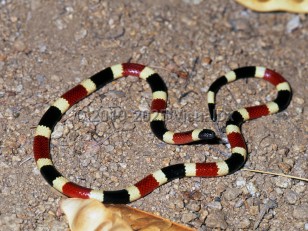Potentially life-threatening emergency
Coral snake envenomation
Alerts and Notices
Important News & Links
Synopsis

New World coral snakes (family Elapidae) inhabit North and South America. They have round heads, round pupils, and 2 short, fixed, hollow fangs in their upper jaws. Of the more than 50 species of coral snake in the New World, only 3 dangerous species (2 Micrurus sp. and 1 Micruroides) are found in the United States. The eastern coral snake (Micrurus fulvius) is found in parts of North Carolina, South Carolina, Alabama, Georgia, Mississippi, and Florida. The Texas coral snake (Micrurus tener) is found in parts of Texas, Louisiana, and Arkansas. The Sonoran coral snake (Micruroides euryxanthus) is found in parts of Arizona and New Mexico.
Coral snake venom is neurotoxic. Neuromuscular dysfunction with respiratory or cardiovascular failure may occur with envenomation.
Coral snakes are shy, and bites are uncommon. In the United States, there are fewer than 20 bites per year (approximately 1% of all snake bites) and no deaths have been reported since coral snake antivenom became available. Most bites (up to 60%) are "dry" bites (no envenomation) because coral snakes must chew the victim's tissue for a brief period to achieve significant envenomation. Victims of coral snake bites typically have intentionally interacted with the snake.
The bite site may reveal multiple small puncture wounds with minimal soft tissue swelling. The victim may complain of mild pain, localized numbness, or paresthesias.
Systemic symptoms, predominately neurological, dominate the clinical picture. With significant envenomation, the onset of symptoms may be delayed up to 10-12 hours but may then rapidly progress. Altered mental status is the earliest symptom. Cranial nerve dysfunction followed by generalized weakness, peripheral paralysis, respiratory failure, and cardiovascular collapse may result.
Coral snake venom is neurotoxic. Neuromuscular dysfunction with respiratory or cardiovascular failure may occur with envenomation.
Coral snakes are shy, and bites are uncommon. In the United States, there are fewer than 20 bites per year (approximately 1% of all snake bites) and no deaths have been reported since coral snake antivenom became available. Most bites (up to 60%) are "dry" bites (no envenomation) because coral snakes must chew the victim's tissue for a brief period to achieve significant envenomation. Victims of coral snake bites typically have intentionally interacted with the snake.
The bite site may reveal multiple small puncture wounds with minimal soft tissue swelling. The victim may complain of mild pain, localized numbness, or paresthesias.
Systemic symptoms, predominately neurological, dominate the clinical picture. With significant envenomation, the onset of symptoms may be delayed up to 10-12 hours but may then rapidly progress. Altered mental status is the earliest symptom. Cranial nerve dysfunction followed by generalized weakness, peripheral paralysis, respiratory failure, and cardiovascular collapse may result.
Codes
ICD10CM:
T63.021A – Toxic effect of coral snake venom, accidental, initial encounter
SNOMEDCT:
217653004 – Poisoning due to coral snake venom
T63.021A – Toxic effect of coral snake venom, accidental, initial encounter
SNOMEDCT:
217653004 – Poisoning due to coral snake venom
Look For
Subscription Required
Diagnostic Pearls
Subscription Required
Differential Diagnosis & Pitfalls

To perform a comparison, select diagnoses from the classic differential
Subscription Required
Best Tests
Subscription Required
Management Pearls
Subscription Required
Therapy
Subscription Required
References
Subscription Required
Last Updated:02/18/2018
Potentially life-threatening emergency
 Patient Information for Coral snake envenomation
Patient Information for Coral snake envenomation
Premium Feature
VisualDx Patient Handouts
Available in the Elite package
- Improve treatment compliance
- Reduce after-hours questions
- Increase patient engagement and satisfaction
- Written in clear, easy-to-understand language. No confusing jargon.
- Available in English and Spanish
- Print out or email directly to your patient
Upgrade Today

Potentially life-threatening emergency
Coral snake envenomation

